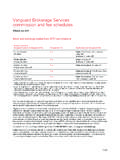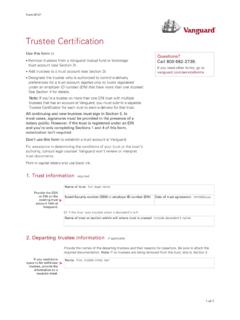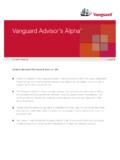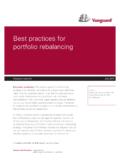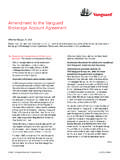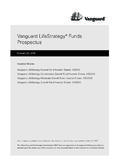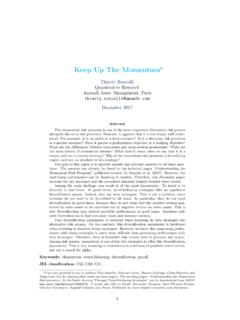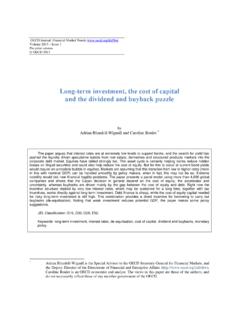Transcription of Best practices for portfolio rebalancing - Vanguard
1 The Bestbuck stopsfor practices here: Vanguard money market funds portfolio rebalancing Vanguard Research November 2015. Yan Zilbering; Colleen M. Jaconetti, CPA, CFP ; Francis M. Kinniry Jr., CFA. The primary goal of a rebalancing strategy is to minimize risk relative to a target asset allocation, rather than to maximize returns. Over time, asset classes produce different returns that can change the portfolio 's asset allocation. To recapture the portfolio 's original risk-and-return characteristics, the portfolio should therefore be rebalanced.
2 In theory, investors select a rebalancing strategy that weighs their willingness to assume risk against expected returns net of the cost of rebalancing . Vanguard research has found that there is no optimal frequency or threshold for rebalancing , since risk-adjusted returns do not differ meaningfully from one rebalancing strategy to another. As a result, we conclude that for most broadly diversified stock and bond fund portfolios (assuming reasonable expectations regarding return patterns, average returns, and risk), annual or semiannual monitoring, with rebalancing at 5% thresholds, is likely to produce a reasonable balance between risk control and cost minimization for most investors.
3 Annual rebalancing is likely to be preferred when taxes or substantial time/costs are involved. Return data for Figures 2, 3, 5, 6, and 8 of this paper are based on the following stock and bond benchmarks, as applicable: Stocks are represented by the Standard & Poor's 90 from 1926 through March 3, 1957; the S&P 500 Index from March 4, 1957, through 1969; the MSCI World Index from 1970 through 1987; the MSCI All Country (AC) World Index from 1988 through May 31, 1994; and the MSCI AC World IMI Index from June 1, 1994, through 2014.
4 Bonds are represented by the S&P High Grade Corporate Index from 1926 through 1968; the Citigroup High Grade Index from 1969 through 1972; the Lehman Long-Term AA Corporate Index from 1973 through 1975; the Barclays Aggregate Bond Index from 1976 through 1989; and the Barclays Global Aggregate Bond Index (USD hedged) from 1990 through 2014. Except as noted, the portfolios are weighted 50% stocks/50% bonds. Notes on asset-return distributions and risk The asset-return distributions shown here represent Vanguard 's view on the potential range of risk premiums that may occur over the next ten years; such long-term projections are not intended to be extrapolated into a short-term view.
5 These potential outcomes for long-term investment returns are generated by the Vanguard Capital Markets Model . (VCMM see the description in Appendix I) and reflect the collective perspective of our Investment Strategy Group. The expected risk premiums and the uncertainty surrounding those expectations are among a number of qualitative and quantitative inputs used in Vanguard 's investment methodology and portfolio -construction process. All investing is subject to risk, including the possible loss of the money you invest.
6 Diversification does not ensure a profit or protect against a loss in a declining market. There is no guarantee that any particular asset allocation or mix of funds will meet your investment objectives or provide you with a given level of income. 2. Vanguard believes that the asset allocation decision Costs of rebalancing which takes into account each investor's risk tolerance, Throughout this paper, the term costs of rebalancing time horizon, and financial goals is the most important refers to: decision in the portfolio -construction process.
7 This is because asset allocation is the major determinant of risk Taxes (if applicable): If rebalancing within taxable and return for a given Over time, however, as registrations, capital gains taxes may be due upon a portfolio 's investments produce different returns, the the sale if the asset sold has appreciated in value. portfolio will likely drift from its target asset allocation, Transaction costs to execute and process the acquiring risk-and-return characteristics that may be trades: For individual securities and exchange-traded inconsistent with an investor's goals and preferences.
8 Funds (ETFs), the costs are likely to include brokerage By periodically rebalancing , investors can diminish commissions and bid-ask For mutual funds, the tendency for portfolio drift, and thus potentially costs may include purchase or redemption fees. reduce their exposure to risk relative to their target asset allocation. Time and labor costs to compute the rebalancing amount: These costs are incurred either by the As part of the portfolio -construction process, it's investor directly or by a professional investment important for investors to develop a rebalancing strategy manager.
9 The costs may include administrative that formally addresses how often, how far, and how costs and management fees, if a professional much : that is, how frequently the portfolio should be manager is hired. monitored; how far an asset allocation can be allowed to deviate from its target before it is rebalanced; and Keep in mind that in addition to these costs, there whether periodic rebalancing should restore a portfolio may be trading restrictions that could limit the frequency to its target or to a close approximation of the target.
10 Of transacting on the accounts. Finally, since there is Although each of these decisions has an impact on a little difference in the results between the frequencies portfolio 's risk-and-return characteristics, the differences analyzed, these costs should be considered when in risk-adjusted returns among the strategies are not very selecting a rebalancing strategy. significant. Thus, the how often, how far, and how much are mostly questions of investor preference. The only clear advantage for any of these strategies, so far as maintaining a portfolio 's risk-and-return characteristics, and without factoring in rebalancing costs, is that a rebalanced portfolio more closely aligns with the characteristics of the target asset allocation than a portfolio that is never rebalanced.
